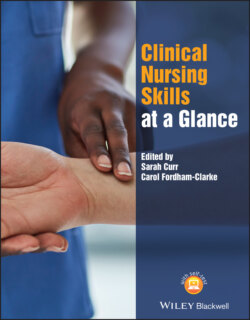Читать книгу Clinical Nursing Skills at a Glance - Группа авторов - Страница 12
Оглавление1 Introduction: the setup of this book and how to use it
This book is separated into 12 key sections with each section related to a system of the body. The exceptions to this are Chapter 2 (Principles of Skills) and Chapter 3 (Mandatory Skills). The principles of skills highlight key considerations for your healthcare practice, with the mandatory skills focusing on key skills required prior to entering the clinical environment to ensure safe practice. As such, these sections are intended to be read first.
Within this book each page is presented in an easy‐to‐follow double‐page spread. This double page provides written content and tables, figures, and photos, which add a visual context and support.
The United Kingdom (UK) National Health Service Knowledge and Skills Framework (KSF) (NHS Employers 2019) was key in the development of this book due to its focus on the necessary knowledge and skills required to enable quality care provision. As such, each chapter provides both knowledge and skill, thereby ensuring an evidence‐based approach to each skill. Each chapter has a brief background section where knowledge is provided with guidance for the procedure. The skill is then outlined in the sections on influencing factors, equipment and procedure. Each chapter also has a red flags section for specific signs and concerns to look for as well as actions to take.
The skills in this book have the potential to be used for all healthcare professionals but there is a recognition that much of these skills will be undertaken by the nursing workforce. As such this book provides skills that align with the UK Nursing & Midwifery's Council (NMC) Standards of Proficiency for Registered Nurses (2018). Throughout the book, and weaved across each chapter, are the core platforms:
Being an accountable professional.
Promoting health and ill health.
Assessing need and planning care.
Providing and evaluating care.
Leading and managing care and working in teams.
Improving safety and quality of care.
Coordinating care.
We feel that whist skills have changed to incorporate the complex care delivery now required, these skills reflect commonly performed procedures in practice as well as those highlighted within the annex of the above publication (NMC 2018). We would also like to emphasise that all these skills require training and an assessment of competence and that this book is intended as a learning adjunct to clinical practice. Prior to performing each skill, you must have been assessed and deemed competent, thus having the necessary knowledge and skills to undertake the procedure.
Do use this book to inform your clinical practice, always ensuring that you use it whist following local and national policies and guidance. The purpose of this book is to provide a quick visual approach to essential healthcare skills and as such should be supplemented by material providing detailed theory underpinning the skills. However the knowledge gained within these chapters can be further consolidated within our online complementary package, which is available in www.wiley.com/go/clinicalnursingskills. This will test your knowledge through quizzes and case studies to ensure further preparedness for practice. Enjoy!
References
1 NHS Employers (2019) Simplified Knowledge and Skills Framework. https://www.nhsemployers.org/SimplifiedKSF (accessed 5 December 2020).
2 Nursing & Midwifery Council (2018). Standards of Proficiency for Registered Nurses. London: Nursing & Midwifery Council.
